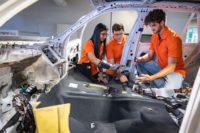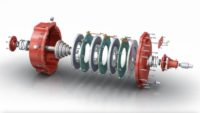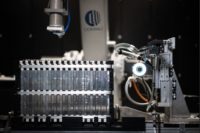HETHEL, England—Lotus Cars has a long, proud history of producing cutting-edge vehicles. For more than 60 years, the company has been known for its innovative designs and a lineup of legendary race car drivers such as Jimmy Clark, Graham Hill, Jochen Rindt, Emerson Fittipaldi, Mario Andretti and Ayrton Senna.
Lotus recently unveiled the E-R9, a next-generation electric endurance racer that could be on the starting grid of circuits around the world by the end of this decade. Finished in black and gold livery as a nod to Lotus’ pioneering motorsport heritage that led to 13 Formula 1 world championship titles, the EV features a sleek fighter jet-style canopy centrally mounted in a delta-wing upper body.
Innovations include advanced active aerodynamics with “morphing” body panels and vertically mounted control surfaces to assist with high-speed cornering. The car was created by Lotus Engineering, the consultancy division of the automaker that specializes in R&D projects for external clients. The E-R9 serve as a technology showcase of its philosophy, capability and innovative spirit in the fields of advanced electrified power trains and aerodynamics.
E-R stands for Endurance Racer, while 9 is the car’s competition number carefully chosen in tribute to Lotus’ racing heritage. It was in a Lotus Mark IX that the race team made its debut appearance at the 1955 Le Mans 24 Hour race, with company founder Colin Chapman among the drivers competing.
“What we’ve tried to do is to push the boundaries of where we are technically today and extrapolate into the future,” says Richard Hill, chief aerodynamicist at Lotus. “The E-R9 incorporates technologies which we fully expect to develop and be practical.
“Chief among the car’s aero innovations are its morphing body panels,” explains Hill. “Located across the delta-wing profile, this adaptability—where active surfaces can change their shape and attitude to the air flow either at the press of a button by the driver or automatically according to performance sensor inputs—would deliver minimum drag on the straights and maximum downforce in the corners.
“Vertical control surfaces at the rear would generate aerodynamic forces to help the car change direction, without the limitations of grip at the tire contact patch,” adds Hill. “The result is a racer that’s partly driven like a car and partly flown like a fighter jet.”
The Lotus E-R9 features an advanced electric drivetrain powering each wheel independently, a system enhanced with torque-vectoring. It builds on technology already integrated on the Lotus Evija pure electric hypercar (due to begin production this summer), though for the E-R9 would be fully adjustable by the driver on the move.
“Battery energy density and power density are developing significantly year on year,” says Louis Kerr, principal platform engineer for the Lotus Evija and technical director at Geely Group Motorsports International. “Before 2030, we’ll have mixed cell chemistry batteries that give the best of both worlds, as well as the ability to ‘hot-swap’ batteries during pitstops.”



